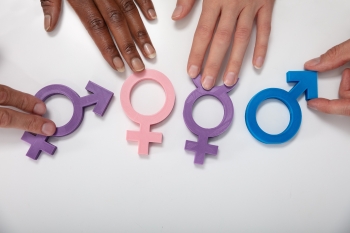
What is Genderfluid Identity?
Have you heard the term “genderfluid” of late and gotten curious? Maybe you’ve always appreciated a bit of both worlds when it comes to gender expression. Regardless of what angle you’re approaching from, we’re here to shed some light on an infrequently discussed identity.
So what is genderfluid identity? The term “genderfluid” describes the experience of feeling multiple different gender identities (masculine, feminine, or nonbinary) over time – though the exact interval varies from person to person. Some genderfluid folks go through longer periods of associating more with one gender identity than another, while others fluctuate regularly based on the social interactions and power dynamics of daily life. There is a lot of variation in how people experience genderfluidity, but the feeling of a non-stable or “in flux” identity is common among those sharing this label.
Is Genderfluid the Same as Nonbinary?
While “genderfluid” falls under the same category of gender-nonconforming identities, it is distinct from the label of “nonbinary” in that nonbinary people generally do not feel either predominantly feminine or masculine. Genderfluid people can still associate with binary genders, they are just not exclusively tied to one identity that endures throughout their lifetime.
Similarly, “genderqueer” is a broader term that people use to describe themselves as some form of gender-nonconforming but feel that a vaguer term is sufficient to describe their experience.
Still a little confused about “what is genderfluid identity”? Consider the examples below:
Example 1: Jen
Jen is a twenty-year-old Chinese American person who identifies as genderfluid. Most of the time, they use they/them or she/her pronouns. Jen studies biology, and in college, they introduce themselves with both sets of pronouns in the beginning of the semester. Some teachers and classmates are more understanding than others, but most just continue to use “she/her” when referring to Jen – which isn’t wrong…but also doesn’t feel complete.
Jen manages this feeling by talking with friends they met through their college’s Gender and Sexuality Alliance (GSA), several of whom also identify as genderfluid or nonbinary. These friends use mostly they/them pronouns to refer to Jen, since they know that a lot of classmates still see Jen as a woman and use she/her. Jen appreciates this and feels seen.
Most of the time, Jen feels that the “nonbinary” label fits them pretty well, as they don’t feel strongly about their connection to femininity. They dress fairly androgynously in their day-to-day life, but there are times when it feels good to wear dresses and look sexy in a feminine way, too. Lately, though, they’ve also been experiencing joy in dressing more masculinely – they wore a suit jacket to last week’s party and got mistaken for a man several times that night.
Instead of feeling the need to correct these strangers, Jen felt a rush and began wondering what it would be like to test out he/him pronouns with a trusted friend when they’re feeling more masculine. Something about it felt good and right – just like when they get acknowledged with they/them pronouns. One of their friends is really good about checking in with them periodically to see if they’ve changed how they want to be referred to, so Jen decides to ask this friend to call them “Jem” next time they hang out in order to test how it feels.
Example 2: Malachai
Malachai is a forty-five-year-old African American person who identifies as genderfluid. Malachai is an actor and an educator, and he has performed in many plays over the years as well as taught a number of acting classes. He also participates in drag shows regularly as a hobby, competing as his exaggerated persona, Miss Malady. Because of his interest in drag, several directors over the years have cast him in female roles as well as genderless gods and various, nebulous creatures. Malachai has enjoyed all of these performances, as they give him a chance to explore new ways of existing in the world.
Growing up, Malachai generally thought of himself as “male” – he was assigned male at birth (AMAB) and related well enough to other boys socially. Though, that would sometimes fall apart when he expressed interest in playing imaginative games with the girls in his class; his male friends would make a big deal out of him being a “sissy”, and he just didn’t see what all the fuss was about crossing gender lines. Later, once he became a young adult, he was happy to cast off the social pressures of teenage boys and enter the vibrant world of acting. He befriended people of all identities and genders in the acting realm – many of whom were queer. In this freer environment to explore, he took up his hobby of drag.
As the years pass, though, Malachai begins to wonder if his feminine side is a larger part of him than he thought; he begins to ask himself “what is genderfluid identity?” Recently, he’s been enjoying casual femininity that differs greatly from his drag performances – while performing drag, he is putting on a show. He is amplifying traditionally feminine traits to a level rivaling parody. But that is not the kind of femininity that he’s been partaking in outside his hobby.
Lately, he’s been buying some sundresses that are more subdued than anything he would wear as Miss Malady, and he’s found comfort in walking and talking a little more gracefully, like he’s preparing for a role. But it’s not a role – the character he’s playing is himself, but a softer, different version than he’s used to.
He decides he likes her. Right now, this is who he wants to be. He doesn’t view it as forsaking the more masculine version of himself – that has felt right for him for a long time – instead, it’s more like an unfurling of a larger, more complex version. One that permits him the grace to change and change back, if necessary. A fluid him that embraces the intricacies of gender identity and expression.
Gender as a Performance
In the last example, we discussed the intersection of gender and acting, which is an important aspect of understanding modern theories surrounding gender. Judith Butler, a renowned academic in this realm, approaches the question “What is genderfluid identity?” by explaining gender as a role we play, based on the script of societal expectations during this place and time. What is “feminine” in one culture does not always translate to another; what is considered “masculine” in this era does not always align with the previous. Therefore, what we think of as a “natural” expression of being male or female usually reflects more about our society than it does our biological compulsions.
Therefore, it is important to understand that gender is a role performed by everybody – not just trans people. A man must exert a significant amount of effort to portray himself as “masculine”, even if it doesn’t always feel like a conscious choice. He likely takes great pains to ensure that his hair stays the proper length, his clothes are manly, he’s wearing the “right” colors, he’s assertive, he spreads his legs when he sits as opposed to pressing them together, his voice isn’t too high, he’s not overly physical or affectionate with male friends, he seems sexually experienced, he remains “cool” instead of overly enthusiastic – the list goes on and on. But since we expect these behaviors from men in the U.S. at this point in time, it is easy to forget that they are learned, rather than inherent, traits.
So how does genderfluidity tie in? Well, if you acknowledge that gender is a role rather than a rule, it can be easier to break gendered expectations and explore what different roles feel like to you. Does acting in accordance with your assigned sex at birth feel comfortable to you? Or does another gender expression feel better? Do certain roles feel right in some scenarios but not others? Gender identity, like sexuality, is a spectrum, but you need to allow yourself grace in “not knowing” before you can seek and find answers.
You May Be Genderfluid If…
- You feel uncomfortable being seen as cisgender (the gender typically associated with your assigned sex at birth).
- You feel like an outsider in highly gendered events or conversations.
- You do not feel exclusively male, female, or nonbinary.
- The way you perceive your gender shifts over time.
- The way you perceive your gender shifts based on the people you’re around and the spaces you occupy.
- You feel mostly gender-nonconforming, but you still identify with a binary gender identity in certain situations.
- You’ve always loved to play dress-up, but the characters you’re inventing – or the heroes you’re imitating – differ from your assigned sex/gender. (Bonus: you really, really love Halloween.)
- You know you’re queer, but you’ve been struggling to find an exact label that captures all the different aspects of your relationship with gender.
If some of these apply to you, then it’s possible that you’re genderfluid! On the other hand, it’s also possible that you’re not. It’s completely okay to identify with these experiences and not feel that “genderfluid” is the best descriptor for you – you might also be someone who doesn’t like labels in the first place. The most important part of exploring your gender identity is determining what feels comfortable for you personally.
I Think I’m Genderfluid…Now What?
Congratulations! You’ve asked yourself the question: “what is genderfluid identity?” and it led you to a new and exciting discovery about yourself. For many, attaching a label to a newly discovered part of you can be relieving, but if this is something that causes any feelings of distress, therapy can be a great opportunity to talk this through with a trusted professional. If you feel therapy could be beneficial for you, feel free to give us a call (215-922-5683) or schedule an appointment online!











